ASUS G73Jh: Today's Top Gaming Laptop
by Jarred Walton on April 17, 2010 2:25 AM ESTG73Jh: High-End DirectX 11 Gaming
We don't have a lot of high-end notebooks in our updated gaming benchmarks, but we do have the Clevo W870CU we can still use for comparison. Note that it has a faster 920XM CPU to help out, but we appear to be GPU limited in the majority of titles. We were going to include results from the Dell Precision M6500, but gaming performance with the Quadro FX 3800M is a bit erratic and we're not sure all of the games rendered correctly. So we've got two sets of benchmarks today: first a comparison at high quality settings and 1600x900 (with 1080p results and DX11 as well where appropriate); second will be a look at how a high-end laptop like the G73Jh compares to midrange laptops at 1366x768 using our "midrange" settings.
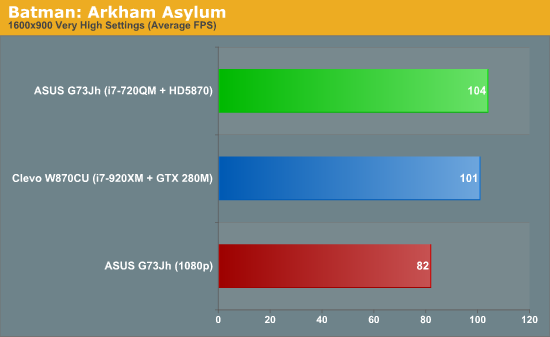
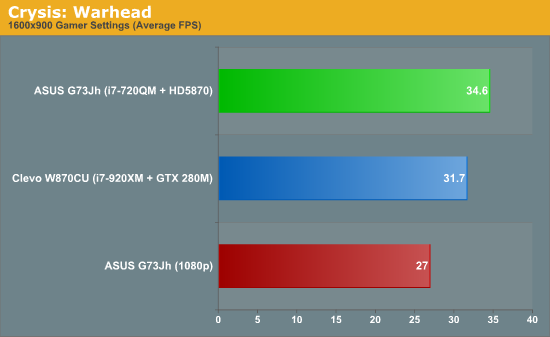
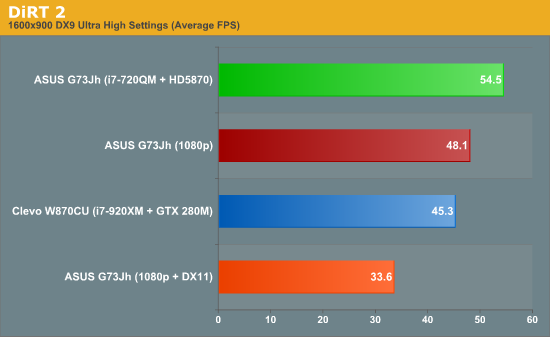
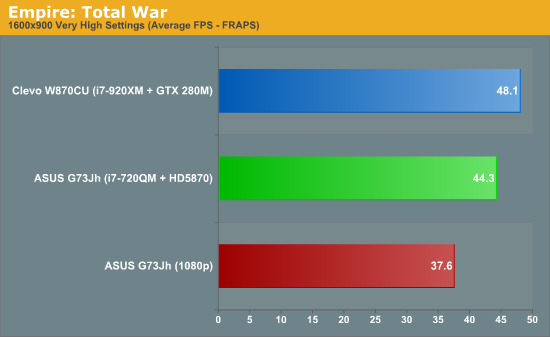
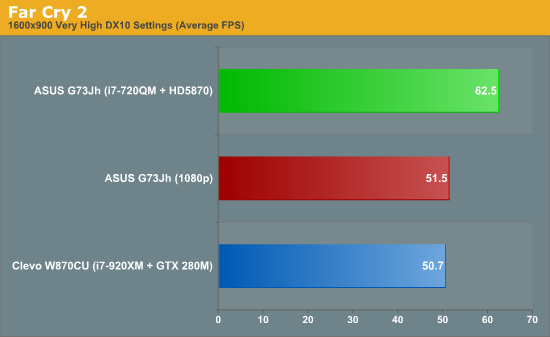
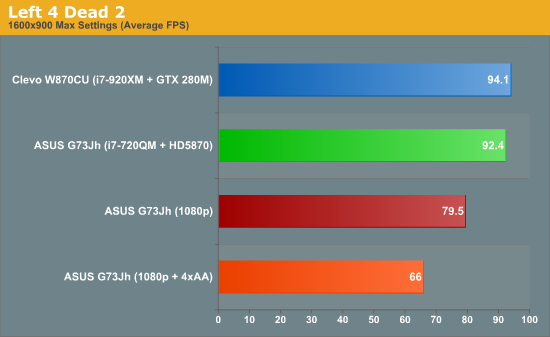

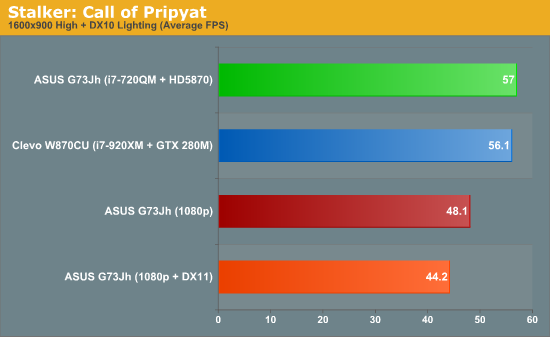
The ASUS G73Jh outperforms the Clevo W870CU in virtually every game we tested; Empire: Total War and Left 4 Dead 2 are the two exceptions, but here the performance gap is generally small—Empire: Total War is the larger difference with a performance advantage of 9%. (Note that the CPU may be part of the reason the W870CU wins, but we can't confirm at present—stay tuned for an article that will show exactly how the mobile GPUs stack up against each other with the same CPU.) Some of the titles where the G73Jh wins are also essentially tied, but Crysis: Warhead and Mass Effect 2 both show an 8-9% advantage. The two games where the HD5870 wins big are DiRT 2 (20%) and Far Cry 2 (23%).
Of course, we also need to discuss feature sets; while the GTX 280M (and the slightly faster 285M) aren't significantly slower, the HD5870 supports DX11. You can see the DX11 performance in DiRT 2 and STALKER, so there's obviously a compromise between performance and image quality, but given the pricing there's no reason to give up DX11 support for a slightly slower DX10 laptop—especially now that AMD has monthly mobile drivers coming out. You can now get the Clevo W870CU with HD5870 or GTX 285M; putting components equal to the G73Jh into such a notebook we ended up at a final price of over $2200, and that doesn't even account for the puny W870CU battery and other design elements.
There are still faster gaming notebooks, of course. We don't have updated results for the ASUS W90Vp (HD 4870X2) or any of the SLI GTX 280M/285M notebooks, but there are going to be plenty of games where the extra GPU shows its muscle. The problem is that you're now stuck deciding between DX11 support or a second GPU, unless AMD releases a mobile 5870X2 or 5970 or whatever they choose to call it (and they probably will at some point). Also, let's not forget that the second GPU means even heavier and more power hungry laptops, with a higher price as well. The Clevo X8100 is now the current champ when it comes to notebook gaming performance, but if we configure such a laptop with a 720QM, 2x2GB DDR3, and 2x500GB hard drives the price comes out to over $2600 (i.e. at AVADirect.com), and you still get the gigantic glossy Clevo chassis. If you like the design and you're willing to pay the extra $1000, GTX 285M SLI should provide roughly 50% more graphics performance than the G73Jh's HD 5870, but right now there are very few games where we truly feel the need for something faster.










72 Comments
View All Comments
DoeBoy - Saturday, April 17, 2010 - link
Yeh my g50vt is stll working well and I can vouch for ASUS meaning gaming laptop. It does get hot as hell thou. Even with a cooler running it gets very hot. I would only buy this sucker if I could see the solution they have going. The g50 does not even have a intake fan at all and the slits in the bottom are so small how could u ever pull a considerable amount of air through them?bennyg - Saturday, April 17, 2010 - link
ditto for the G51J-A1No dedicated intake for a single fan 45W CPU and ~58W GPU... that's why so many have been making swiss cheese of the CPU Door Assembly.
Add to that the conservative fan control which kicks up to highest only when the GPU's already scorching (93C) and cycles on and off even when GPU utilisation is 100%.
As an indication of how underutilised the cooling system is - when I tested stable max OC (16% GPU core, 20% shader, 20% memory, or 580/1500/1000), max temp is only 3 degrees higher... 96C.
Soooo wish I'd known the g73 would be out 2 months after I got this :(
frombauer - Saturday, April 17, 2010 - link
Why 1080p? Text must be way too tiny, and it impacts game performance. Much better if this was 17" with 1680x1050 (16:10 even better).ATC9001 - Saturday, April 17, 2010 - link
It may seem like that but it's really not, my 17" gateway had the 1920x1200 and I thought the same thing (I also had a 24" 2405FPW)...but these resolution is fine. I also decided to go with a 1920x1080 for my 15", worst case I just enlarge the text, but the big thing is having that much desktop space is nice, once you go big you can't go back!bennyg - Saturday, April 17, 2010 - link
This is a YMMV issue.I absolutely could NEVER go back to a 1280x800 or 1366x768 on a 15". Having used a high res screen for over a year, everything at the lower res just seems wierdly magnified.
Yes fps may be lower but there are many games where 1080p on med looks better than 720p on high settings, and I'd much rather have a good game on low/med details than a borefest at Ultra High anyways.
Besides, I don't do gaming 100% of the time on this thing anyway; I can't think of any other reason how a lower res screen would be advantageous. BTW - bad eyesight does not count (google DPI setting in Win7)
JarredWalton - Saturday, April 17, 2010 - link
Keep in mind that you're generally closer to a laptop than you are a desktop display. I played a lot of games on the G73J and never felt text was too small, which isn't something I can say for my 30" desktop display. And as a user of 120dpi setting in Windows, I have to point out that there are drawbacks. Text is larger but images remain the same, and there are a few odd glitches in some programs where text wraps out of view because the font size changed. Most apps assume everyone uses 96dpi; MS apps are usually fine, but try it out on any PC and you'll notice some differences in how things look. It doesn't just magnify everything (which would be the ideal solution IMO... though images would then become blurry). In a pinch, you can always run the LCD at 1600x900 to increase the DPI and get the same effect, but I really do appreciate screen real estate.For reference, DPI on a 30" LCD at 2560x1600 is ~100 (.252mm dot pitch). DPI on a 17.3" 1080p laptop is 127 (.217mm dot pitch). 1600x900 at 17.3" puts the DPI at 106, so it's similar to what you'd get on a 30" LCD. But if you're used to 24" WUXGA and you sit at the same 2-3' distance, you'll definitely feel things get a little cramped. Given that it's hard to find good quality laptop LCDs, there's no way I'd recommend going to a lower resolution panel unless it keeps all the good aspects, and really I prefer 17" laptops stick with 1080p/WUXGA displays.
chrnochime - Monday, April 19, 2010 - link
I don't know about you but I'd prefer to not have to squint when I'm working away on a laptop, especially one that's already 15+" already. Besides, with the larger DPI setting, everything is just way to magnified, and which kind of make it the same as using a lower res anyway.just4U - Saturday, April 17, 2010 - link
Looking at this in comparison to Anand's review on the Mac book pro I have to say .. this one seems to actually be worth the money.I'd have like to have seen more on heat issues as well since that's a concern for some with units like this. Still it's worth a look. I don't normally buy laptops but I'd seriously consider something along these lines. Given the option I'd probably tone down to a lesser cpu mind you.. but that's just me :)
JarredWalton - Saturday, April 17, 2010 - link
Temperature data is listed on page 2:"As you might expect from the noise levels, temperatures are also excellent—perhaps the best we've ever tested, and certainly the lowest we've seen on a gaming notebook. The palm rests stay at room temperature while the touchpad is a few degrees warmer. The rear of the chassis is about 5C hotter, but we're still only talking about 31C maximum. Love it or hate it, the wedge-shaped design certainly does the job when it comes to cooling. ASUS puts a couple huge vents at the back of the G73Jh, and their size and location means you don't need a mini-vacuum fan in your notebook."
If you need more clarification, around 31C for the bottom of the laptop in the middle-back section (just in front of the battery). The front section on the sides are 20-21C (room temperature) while the middle front is 24-25C. The back sides are also around 24C top and bottom. Really, the temperatures are largely uniform compared to other notebooks, and the noise levels are truly exceptional. The Clevo W870CU by comparison is horribly loud, with fans that regularly cycle between low and high speeds.
Roland00 - Saturday, April 17, 2010 - link
I don't have the item number on me, and the model isn't on the website. But it is the same as the review with a few additions8gb of ram
Blu Ray Drive
Backpack
for $1699